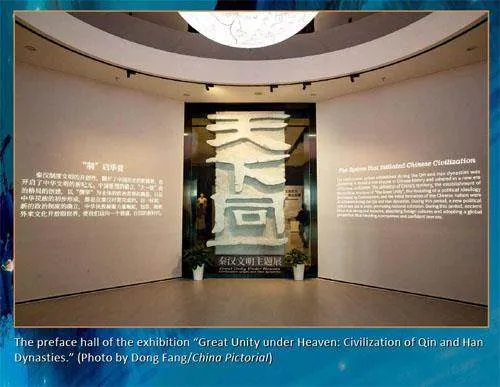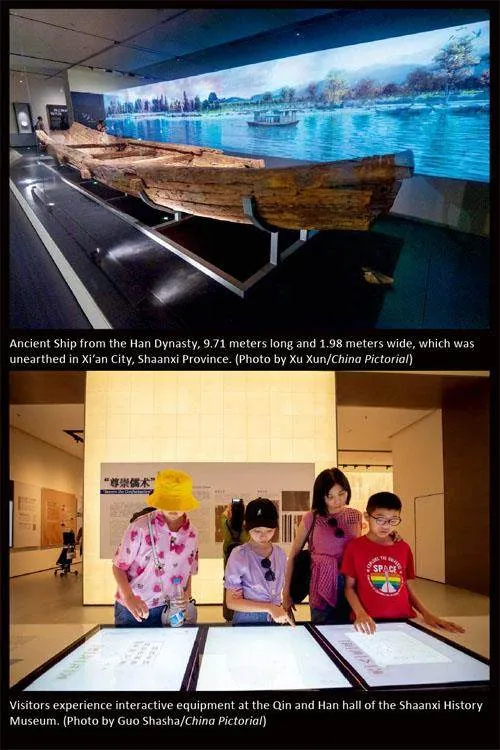Great Unity under Heaven:Qin and Han Civilization


On May 18, 2024,the Qin and Hanhall at the ShaanxiHistory Museumofficially opened. The same day,the permanent exhibition of thehall, titled “Great Unity underHeaven: Civilization of Qin andHan Dynasties,” was unveiled.A total of 732 pieces (sets) ofcultural relics are featured inthe exhibition to demonstratethe various achievements andimportant roles of the Qin(221-207 B.C.) and Han (202B.C.-220 A.D.) dynasties inthe development of Chinesecivilization.
For Peng Wen, aresearch curator at EmperorQinshihuang’s Mausoleum SiteMuseum, the “Great Unityunder Heaven” exhibition atthe Shaanxi History Museum isa breakthrough for her 30-yearcuratorial career.
The Qin and Han hall aimsto demonstrate the origins,development, and contributionsof Qin and Han civilizations.For this purpose, the curatorteam shifted away from pastmethods of displaying generalhistory. Instead, they connectedsmall topics with big history.On the breakthrough historicalphenomenon of “Great Unity,”the exhibition focuses onthe six realms of politics,economics, philosophy, culture,technology, and communication,supplemented by comparisonswith the evolution paths ofcivilizations in other regionsaround the world during thesame period.
The exhibition could be calledan epic of civilization, whichincludes both the turbulentsocial changes on the surfaceof history and the profoundevolutions in the depths ofcivilization. Every exhibitionsection and detail required greatefforts from a team striving forexcellent content and aesthetics.
To distinguish this exhibitionfrom others in the museum,only a handful of the more than730 cultural relics on display arewell-known artifacts, such as theBronze Tiger-Shaped Tally ofDu County, the Gold Monster,and the Empress Seal, and themajority of them were carefullyselected from the warehouseof the museum. To help theaudience absorb the entiretyof the exhibition rather thanany single artifact, the teamcarefully polished every displaytext, connecting the social valueof the artifacts into a line in aneffort to provide concise andpowerful annotations to help theaudience better understand thedevelopment situation of relatedfields regarding the artifacts.For example, the “Developmentof Cattle Farming and IronFarming Tools” section tracesthe progress of the primaryproductive forces such assmelting technology andfarming technology in text,and the section “Emperor Wu’sRectification of the CurrencySystem” demonstrates the roleof six monetary reforms instabilizing the economy.
To better immerse theaudience in the exhibition,the team developed nine largemultimedia installations topresent extended effects echoingeach theme in a charmingdigital theatrical environment.For example, the multimediainteractive equipment“Managing Mountains and Seas”shows the development of thesmallholder economy and theprosperity of the people at thattime.
The exhibition also shedslight on the evolution ofcivilizations in other partsof the world during the sameperiod, positioning Qin and Hancivilizations in a grander globalcontext. When showcasing thegreat unity in the Qin and Handynasties, the expansion routesof the Assyrian Empire, PersianEmpire, Macedonian Empire,Roman Empire, and MauryaEmpire are listed side by side.When narrating the agriculturaleconomy of the Qin and Handynasties, an introduction tothe agriculture, cash crops,and currency of the RomanEmpire is also provided. Whendisplaying the developmentof Confucian thoughts, thebeliefs of the Persians, as wellas the main philosophical ideasof ancient Greece and ancientRome, are also included.
“Every civilization has itsuniqueness. Therefore, theevolution of civilizations cannotbe summarized by a single law.We also show the evolutionof other civilizations in hopesthat the audience can recognizethe uniqueness of Chinesecivilization,” Peng stressed.

